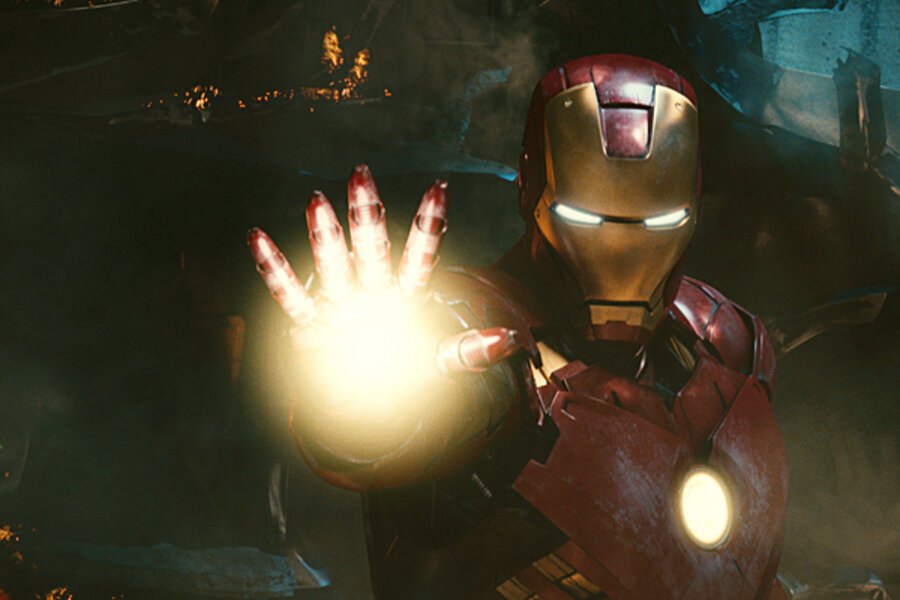Why Iron Man 2 ignores Hollywood 3D mania
Loading...
| Los Angeles
Summer movie-going begins at midnight with “Iron Man 2,” the Marvel sequel projected to threaten the first-weekend box-office performance of the current record-holder, 2008’s “The Dark Knight.” But remarkably, in the new Hollywood 3D bonanza led by the best-selling movie of all time, “Avatar,” the Iron Man 2 is coming to theaters in good, old-fashioned 2D, no 3D version in sight.
There are good reasons for that – primarily that the film was already in production long before James Cameron showed the industry the power and promise of 3D moviemaking.
But the sky-high expectations for the Robert Downey Jr. star vehicle raise questions about the current 3D craze in Hollywood, one which has led to the awkward, last-minute conversion of films such as “Clash of the Titans,” from 2D into 3D, as well as virtually every studio searching through its vaults for films to “re-master” in 3D.
3D is already a mainstream filmmaking tool, says David Wertheimer, executive director of the Entertainment Technology Center at the University of Southern California. “There is no major film going into production today that doesn't have people asking whether it should be in 3D or not,” he writes in an e-mail.
“It is a revolution, like color or sound, but the analogy is not perfect. 3D will not reach 100 percent penetration like those technologies did. Just about any film could be better with 3D, but for a lot of reasons, it will be a long time before even a majority of them are offered in 3D, much less all of them.”
As revenues from 3D films rise, there is a great temptation to see the technology as the salvation of the industry, says Paul Dergarabedian, president of Hollywood.com Box Office. Recent numbers are indeed impressive, he points out, noting that through this past weekend, four 3D films have generated 25 percent of this year’s domestic box office – some $850 million. But, he cautions, “bad 3D, like bad movies, can kill the industry at any time.” Only five years ago, the industry was languishing with attendance at its lowest in decades for a simple reason – Hollywood simply wasn’t turning out films audiences wanted to see, he adds.
Filmmaking may be a business, but the most important element of any film is still the story, says filmmaker Hezekiah Lewis, who teaches at Villanova University. “If the story is compelling, the film will be a success despite how it was shot,” he says in an email. “The story dictates the visual style. Filmmaking is a visual medium, and not all stories call for a 3D format. Sometimes less is more. Are there stories out there that call for the 3D style? Yes, but I do not believe every film should be retrofitted into that format because it minimizes visual and artistic choices that the filmmaker set out to create.”
Despite reservations about its impact on the artistic side of filmmaking, the wave of audience interest – and willingness to pay higher ticket prices – has sped the long-languishing digital conversion of movie theaters, points out industry analyst Scott Hettrick. “Up until this revenue source gave theater owners a good reason to convert, the technology in most movie houses [was] ancient, essentially the same light-passing-through-celluloid we’ve had for 100 years,” he says.
There are plenty of technical issues to iron out, not the least of which remains the niggling discomfort of even the most sophisticated glasses current 3D equipment requires. But, Mr. Hettrick adds, other countries such as Japan have moved in front of the US. Television stations are already broadcasting in 3D, and cell phones with 3D technology not requiring glasses already exist.
But these days, the DVD after-life of films is as important, if not more, than its theatrical run. Home theater demands for 3D shows may speed the transition to more 3D content. ESPN, DirectTV and Discovery all expect to roll out 3D channels in the near future, with the sports channel already on deck to broadcast the 2010 World Cup Soccer match between South Africa and Mexico in 3D this summer. And, according to iSuppli, Global 3D television shipments will rise to 78 million units by 2015, rising at a compound annual growth rate of 80 percent – from 4.2 million in 2010.
Related:
Marvel deal will build on Disney's Pixar model





